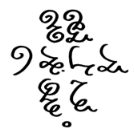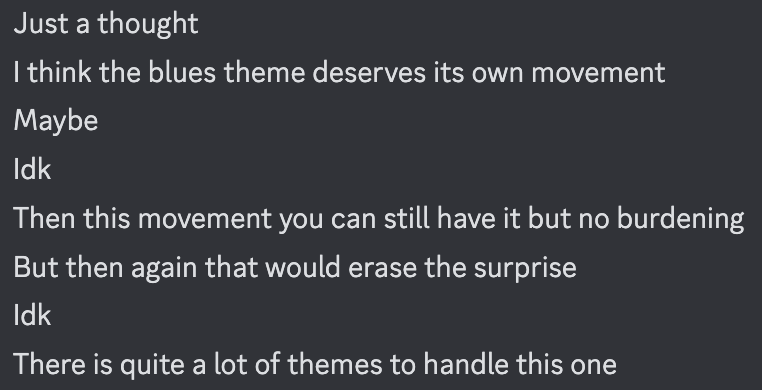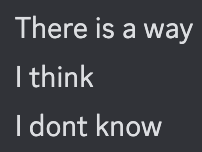All Activity
- Today
-

Dodecaphonic Perpetual Canon for String Quartet.
Fugax Contrapunctus replied to Fugax Contrapunctus's topic in Chamber Music
Much to my wholehearted agreement, you already pointed this out in your review of my other dodecaphonic canon: "Although I have read from Taruskin's Music History book that counterpoint without tonality would be not too meaningful without the rules for dissonances and its resolution, but it is clearly not correct here. Given your ultimate care for preventing clashing dissonances, I find this one actually quite melodious and even tonal, or at least pan-tonal." In any case I don't find Taruskin's assessment entirely correct, just as you pointed out, since care for the clashing and resolution of dissonances need not necessarily be strictly derived from the rules of tonality, but instead out of the composer's own stylistic preference. One of the greatest things I have thus far found true for the dodecaphonic tone row system is that it allows for an immense amount of diversity when it comes to compositional approaches, which is specially true for stylistic notions of what works and doesn't in any given work according to the composer's own intrinsic judgement. In many regards I believe my usage and deployment of contrapuntal techniques to be the polar opposite of Schönberg's in terms of the treatment of dissonance, as in coining the term "emancipation of dissonance" so as to refer to his own proclivity towards unprepared and unresolved dissonances he was so proudly fond of, I believe he essentially stopped hearing dissonances as "ill-sounding" or unpleasant to the ear. For better or worse, my own particular stylistic preferences remain fairly attached to the etymologically quintessential definition of dissonance I just provided, independent of a tonal context. As such, my reticence towards unsing certain intervals has little to do with the standards conventions of tonal preparations and resolutions thereof, but with my own tendency towards finding intervals like minor 2nds and major 7ths quite distasteful to hear in clashing (though slightly more toolerable in suspensions), and also difficult to handle contrapuntally with my current bare-bones approach towards the general treatment of tone rows in my latest canons. - Yesterday
-
Artdreamer77 started following two soft pieces
-
This is good. Simple but refreshing. This is today's inspiration for me.
- 2 replies
-
- originals
- pleasant to the ear
-
(and 4 more)
Tagged with:
- Last week
-
PeterthePapercomPoser started following .
-
@Artdreamer77 The user edited out his content so the conversation has holes. The user also changed the name of the topic to ".". I am going to close this topic to further replies.
-
Artdreamer77 started following .
-
Is my computer not displaying something, or is this post literally just "."? How is this allowed, and how is it offensive to call this spam? EDIT: No actually, is this sarcasm or do I not see something?
-
Alex Weidmann started following Aurora (Ancient Greece inspiration)
-
Aurora (Ancient Greece inspiration)
Alex Weidmann replied to Luis Hernández's topic in Piano Music, Solo Keyboard
Hi Luis, I've become very interested in music from Antiquity, like the Seikilos Epitaph, and Hurrian Hymn to Nikkal. I like the effort you've gone to here with retuning your scale. Octave species used in ancient music seems to be a very rich subject I've yet to fully understand! I sometimes wish film composers would employ the techniques you've used here, so they can create a more authentic musical language to reflect the ancient world. Seikilos epitaph Seikilos stele with poetry and musical notation Type Stele Material Marble Writing Koine Greek Created c. 1st or 2nd century AD, Tralles, Asia Minor Discovered 1883 Discovered by W. M. Ramsay Present location National Museum of Denmark -
Advice on stereo panning of the orchestra
Alex Weidmann replied to Alex Weidmann's topic in Composers' Headquarters
On this point, Bing AI said the following: ### **Considerations for Virtual Orchestration** - **Traditional vs. Modern Balance** – If aiming for a **historical or cinematic** sound, splitting violins left/right can add **depth**. If replicating a **modern concert hall**, keeping both violin sections left is more authentic. - **Stereo Width & Reverb** – Hard panning can feel unnatural; using **subtle stereo positioning** with **reverb** helps maintain realism. - **Genre & Style** – Classical recordings often favor **natural seating**, while film scores may exaggerate stereo separation for dramatic effect. -
Advice on stereo panning of the orchestra
Alex Weidmann replied to Alex Weidmann's topic in Composers' Headquarters
Thanks, that's a good tip! I asked another professional composer about this, and he suggested placing the 2nd violins on the right. So I proposed this arrangement to Bing AI, and it responded: - **Modern Standard (1st & 2nd Violins Together on the Left)** – Most contemporary orchestras place **both violin sections on the left**, with **violas center-right** and **cellos further right**. - **Historical Setup (1st Violins Left, 2nd Violins Right)** – This **antiphonal arrangement** was common in **early 20th-century orchestras**, particularly with conductors like **Mahler and Stokowski**, as it enhances **stereo separation** and **call-and-response effects** between violin sections. - **Film & Studio Mixing** – Many **virtual orchestras** use the **split violin approach** to create a **wider stereo image**, especially in cinematic scoring. -
Yes, it is true that realizing a vision is a process of discovery that may not end up entirely where you imagined, but this passage in the book made me question my own way of looking at it. I think I will read through the book just to get some fundamentals about form and who knows what else, but I understand this book is just one composer's take and I will by no means use that as my only source of learning.
-
Mackenzie joined the community
-
Frankly, I would not take anything Arnie said seriously and would toss his book in the trash, where his "music" belongs as well. Perhaps set fire to it. It is also blatantly false when he says that "No beginner is capable of envisaging a composition in its entirety". Of course they can. Even laypeople can. They are capable of "envisaging" it, but that is different from "realizing" it entirely. The truth is that even if you plan out a structure or form from the get go, pieces tend to undergo metamorphosis as you actually work on them. The music reveals things to you that may not have come to you while you "envisaged" it and every piece is different. On some, you might have thought of a form you want beforehand and you wind up following it exactly. On others, you might realize partway through that actually, it would better if this "B" section didn't repeat after all and you have a better idea. And yes, it can even unfurl like a tapestry on a one-note-to-the-next basis. As an example, on my last album, some pieces I had a very clear picture of how they would be laid out before I even sat down to work on them. But on others, I did not. On one track I wrote, all I knew for certain was that I wanted it to start with some soft horns, and end with a big march that fades out into percussion similar to "The Flag Parade" by John Williams. I wound up having to change the ending because the company I wrote the album for required every track to end on a hit, but everything between the intro and ending was up in the air. It wound being the most popular and best-selling piece on the album — and is also my favorite piece on it.
-
PeterthePapercomPoser started following Etats (baryton & piano) and Sleep (SATB) Original Choral Song – New
-
TJ Jones joined the community
-
https://www.youtube.com/watch?v=Td9pPZojLKg Hey, I'm 17 and I made this choral piece in 2 class periods and just had its world premiere and I would love some feedback! This piece enters an aleatoric section at the end that unfolds without a conductor. It is designed to gradually evolve from independent, overlapping textures into a shared, harmonious cadence. This section represents a journey from freedom to unity, from motion to stillness, from individuality to communion. The endless cry for answers about what happens after death, until it ultimately comes to an end, so it starts chaotic and ends in unity with no conductor thoughts?
-
Henry Ng Tsz Kiu started following Etats (baryton & piano)
-
Krisp started following Etats (baryton & piano)
-
A new poetry from the same Laforgue I can post the poem here, which is a beautiful black diamond (an automatic translation but quite close to the meaning) As always at Laforgue, irony, tenderness, idleness of an impossible platonic love We know that he loved a young Englishwoman with no return, and I think it was she who inspired him his most beautiful pages, here in the evening of his short life. Thank you for your reviews and comments! Ah! tonight, my heart feels sick, my heart is with the Moon! O veils of silence, spread out your still lagoons; O rooftops, terraces, basins, loosened necklaces Of pearls, tombs, lilies, grieving cats — give praise To the Moon, our Mistress to all, in her glory: She is the Host! and silence is her ciborium! Ah! how good it feels, oh! so good and sweet, in the halo Of mourning around this finest diamond’s glow! O Moon, you may find me a bit romantic, But tell me — now and then, wouldn’t it be frantic To think — just between us, and only if you please — That I could be your Columbus, on my knees? Well, let’s not speak of that; let’s chant the midnight rite, Preserved in alcohol, steeped in your delights. Slowing down towards us, O weary City, Fibrous cell with broken organs, withered pity! Remember the centaurs, the cities now erased, Palmyra, and the snub-nosed sphinxes of Thebes the chaste; And what Gomorrah, beneath your Lethe lake, Hides catacombs in honor of barren Astarte’s sake! And how mankind, with his “I love you” clichés, Is much too anthropomorphic in his ways, And knows only how to muddle through his days With hellos and goodbyes while twisting love his way. — Ah! As I was saying, and more than once or twice, That my heart is sick — my heart is with the Moon, precise.
-
LoL haha! Yeah there are a lot of themes here given how tumultous my thoughts were then. I didn't aim the blues theme as a surprise though, but rather (sondern in German I just learnt this morning lol) an escape from the heavy emotions I was facing. I actually like the abrupt retransition as a wake up call from that escape! Thx for your 2nd reply haha! Henry
-
Thx Luis! The shift is also surprising to me to be honest, I never know the music will turn that way until I got that inspiration. I tried to make the transition as smooth as possible since I know it would sound abrupt if the transition is not well handled. The retransition is abrupt since for me it's more a shock call from escapism of jazz. Henry
-
Sorry to hear that. Not sure why it's turned out so bad? Perhaps I've just been lucky, but my pieces seem to come through cantamus ok (e.g. the one below). Not getting any of that strange warbling effect you have. Wonder if notational changes might help? It is quite fussy about notation sometimes. (N.B. In my piece, I had to run it through cantamus twice, as it's half in English, and half in Latin.)
-
Thinking, "I should write a theme first and then a contrasting one," is exactly the sort of thinking about form that he is discussing. You sound like you are well on your way to thinking about the large scale issues with a piece, rather than just writing note by note. It sounds like he's talking about how beginning composers just sort of work from one note to the next without any rhyme or reason. There may be no theme at all, just a random succession of notes that they liked for five minutes straight. Everyone works one note to the next, but the more experience you have, the more you'll be thinking ahead about how to organize yourself in the choosing of those notes. Thinking, I have a fast section, so next I should have a slow one for contrast... that sort of thing. Or, I'm going to have range issues if I give this bit to that instrument without modulating. Do I want to modulate, or do I want to give it to a different instrument... And he wants to suggest some simpler exercises to get you started thinking about these sorts of things before you decide to write a whole symphony. Use fewer instruments. Write a short theme and see if you can turn it upside down. Practice writing a fugue. Also, Schoenberg is writing in a way that makes him sound like a big smarty pants so he can scare you into doing your homework, so don't be intimidated into a state of confusion, just do the exercises. (My best guess at what he was going for at any rate).
-
I recently bought Fundamentals of Musical Composition by Arnold Schoenberg and I am excited to be reading it as it is the first real reading I am doing on musical composition. In the first chapter he writes the following: "A composer does not, of course, add bit by bit, as a child does in building with wooden blocks. He conceives the entire composition as a spontaneous vision. Then he proceeds, like Michelangelo who chiselled his Moses out of the marble without sketches, complete in every detail, thus directly forming his material. "No beginner is capable of envisaging a composition in its entirety; hence he must proceed gradually, from the simpler to the more complex. Simplified practice forms, which do not always correspond to art forms, help a student acquire a sense of form and a knowledge of the essentials of construction. It will be useful to start by building musical blocks and connecting them intelligently." My question is how a composer can in their vision of the composition, imagine the entirety of the form before composing even a single motive. Sure, before beginning a composition, the composer feels the ineffable essence of what they wish to express in their composition, but the form is part of that too? I was surprised to read that a composer does not add bit by bit, since it seems natural to compose by writing a theme, and then a contrasting one. I have not, though, had much success doing so, so I guess I must begin small and internalize form as a begin composing small forms for practice. I may be misunderstanding something, but reading this seemed like a reality check that I was thinking of form wrong as a composer. Or maybe this "spontaneous vision" of the form is something only the greatest of the great composers can master. I don't know; I'm a beginner.
-
Lo, the full, final sacrifice (Finzi) orchestration
develop331 replied to develop331's topic in Orchestral and Large Ensemble
@Alex Weidmann hello, I tried using cantamus but it didn't really go well, it genuinely sounds like a mixture between a dying cat and an air raid siren. Listen to it from 10:10 or so and the quality really goes down quite quickly 🙂 Thanks for the suggestion though, it was fun trying out. -
Lately, I've been thinking and imagining how Ancient Greece was reinterpreted in Impressionism. And well, all of that inspired me to write something. The dawn is that moment before sunrise when there is already light. For a brief explanation of what resources I use: Aurora
-
I really like how it turned out. Both the sounds you used (the organ in particular, or whatever it is) and the composition itself.
- 3 replies
-
- early music
- baroque
-
(and 7 more)
Tagged with:
-

Advice on stereo panning of the orchestra
AngelCityOutlaw replied to Alex Weidmann's topic in Composers' Headquarters
I've actually been thinking about this a lot lately. I was studying the film scores and other orchestral recordings of the '90s in particular and trying to figure out, aside from things like tape, what made them sound the way they do. In researching it, I found that in the way it was recorded, mostly owing to technology of the time, is that the stereo field actually has a strong center. I don't think one gets the best results by trying to pan the orchestra precisely to where they would sit in real life, because it creates an image that is just too wide for a stereo recording. Which is a 2 dimensional thing, unlike the 3D sound you would experience if you were actually seated in a hall. It's like bass. As you mentioned, the low strings being off center feels wrong on a recording. I usually use a mono summing plugin to put the basses right in the middle. That's not "realistic", but it's what works for a recording. What you can do, is pan the orchestra basically according to its seating, but then use a mono plugin to slightly reduce the overall stere field by around 15% or so. You can still tell that the instruments are panned, but they all have more of a center image than they do "out of the box". -
Hey @Henry Ng Tsz Kiu! I just thought I'd have another go at some random impressions to your random sounding 3rd movement! LoL I feel like measures 8 - 10 should be more different sounding rhythmically from 11 - 12. Right now they sound really similar even though the rhythms are clearly supposed to be different, which I think is just a result of your lazy right hand! LoL The chord in measures 16 - 18 sound really muddy and thick in the bass range (which is very Beethovenian of you!). I am not a particular fan of that aspect of both yours and Beethoven's music though. I like the confused allusion you make at measure 20 to one of the other movements of this sonata (I don't remember which right now and I'm too lazy to check LoL). It does really sound strange and confused like the music momentarily doesn't know where it's going. I like how you invert the main Allegro theme in the bass in measure 29. Cool canonic imitation! I thought the transition at measure 38 could have been milked further for a longer amount of time to give a more complete sense of transition (especially since you had just finished a 12 bar phrase and keeping the number of bars even numbered in each phrase might have been more appropriate here). I like the transition to a Revolutionary Etude style of accompaniment in measure 39! But in your favorite key of C# minor instead of C minor as in Chopin's piece, which I think makes it a little bit more difficult to play. Nice Locrian inflection at bar 47 which also seems like an allusion to the Revolutionary Etude since Chopin kind of does the same thing with the harmony at a certain place. I like how you gradually foreshadow the Nihilistically Scherzando section in the crazy part (63 - 71). I totally neglected to realize and mention how the Scherzando is both a 12-bar blues and includes a melody from somewhere before interweaving in between the crazy dotted rhythms! The constant juxtapositions between quick Allegro Agitato phrases and slow Adagio question-like phrase derived from another movement are really musically interesting and dramatic! I don't really feel like the transition at measure 183 does a good job at preparing the listener for the beautiful sweet appassionato melody you expose in the next bar (which I know is another quote of a melody from one of the other movements but I don't know which LoL). Nice canonic alternation between the right and left hand playing the melody in the appassionato section. I know you consider bars 221 - 241 as the most impressive part of this movement, but I don't really like it that much personally. I know it must have been difficult to play and it's a great technical feat to be able to execute! But musically it just doesn't do it for me LoL. I like how the recapitulation creates another juxtaposition between the crazy 12-bar blues material and the Adagio allusion. Are the pentatonic scales the quote of your Sextet? I think it's note entirely out of place in this piece. Nice ending - it sounds quite conclusively finished after a monumental work. Bravo! Thanks for sharing!
-
Hi Maggie! Thx! The recording is far from perfect, it took me the 4th take to get this recording. The rent of the studio lasts only an hour so I took the last recording as the best one. I did get touched playing this recording, esp. after the final C sharp minor blow I can barely made those 3 digs of graves of that C sharp minor chords, due to desolation in myself as well as in the music. Thx! I like them too, esp. the crazy section since it's indeed a bit hard and technical to change btw styles. Yeah for me coherence is always the most crucial aspect in my own music. I have to make the movements in a multimovement work is indeed connected in a meaningful way temporally, otherwise they shouldn't be put together in the firt place. Through reappearence and variation the same theme and motive will have different narrative and emotional significance. Thx for your review! Henry
-
stewartIM joined the community
-
This is a dreamy and delightful piece, which benefits greatly from the sound of the electric piano, Rhodes, or whatever.


.thumb.png.8b5b433a341551e913a34392660bc95b.png)







